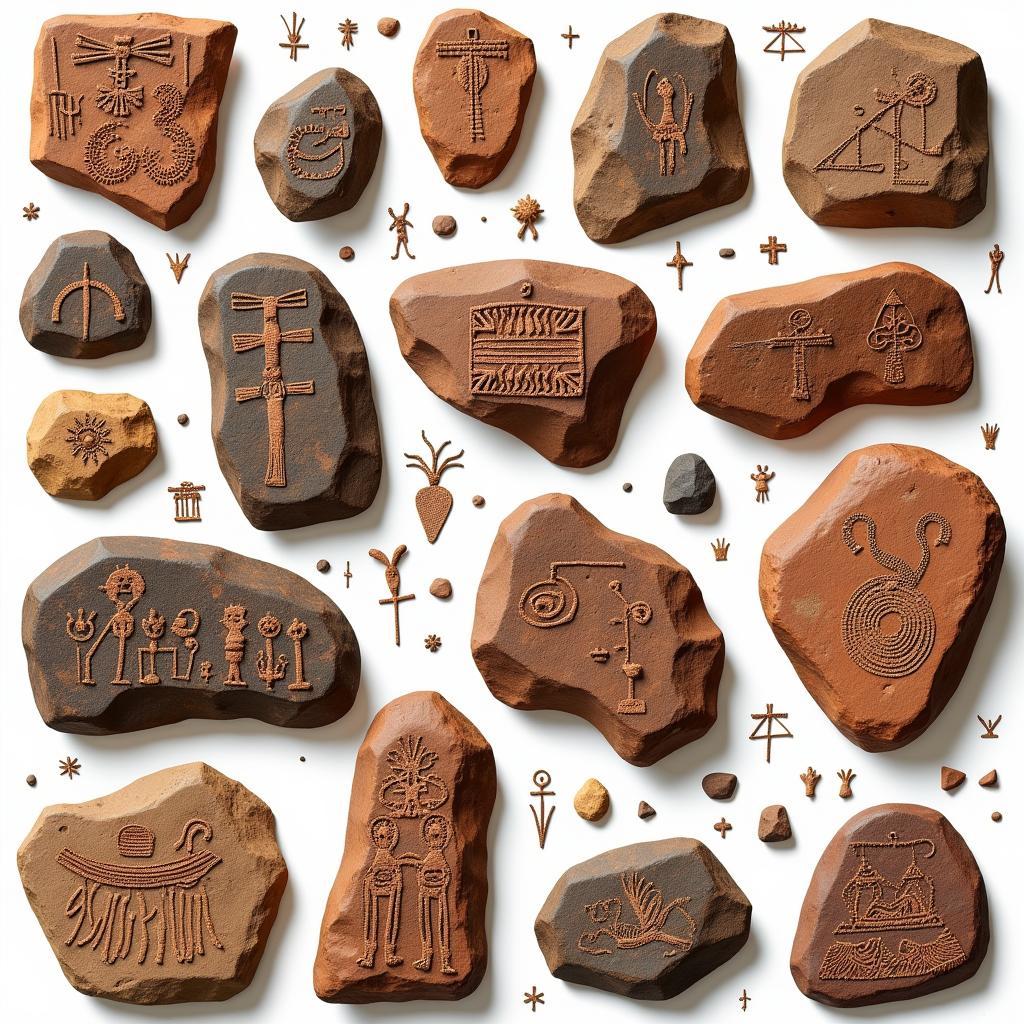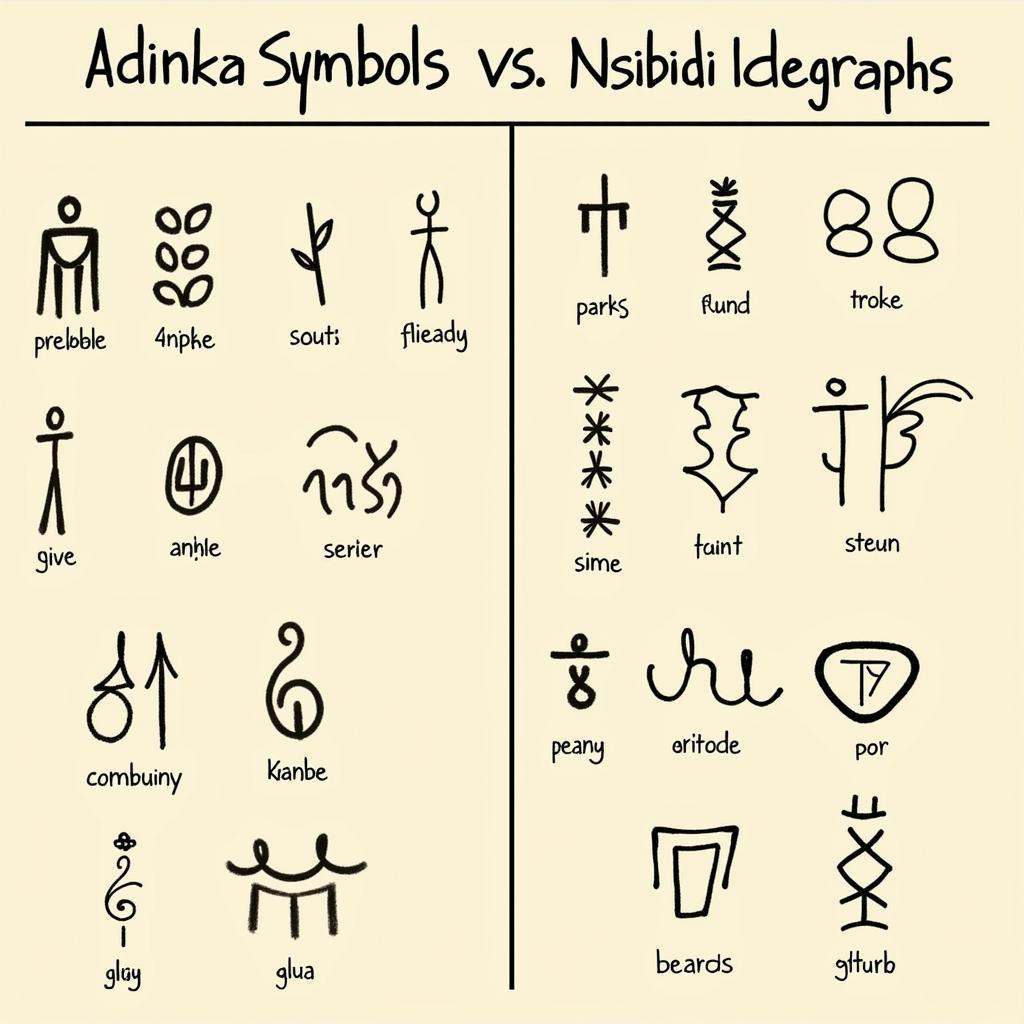Unraveling the Mysteries of African Glyphs
African Glyphs offer a fascinating glimpse into the rich history and diverse cultures of the African continent. These symbolic representations, often found in rock art, pottery, textiles, and other artifacts, hold a wealth of knowledge waiting to be deciphered. Beyond their aesthetic appeal, African glyphs provide valuable insights into ancient belief systems, storytelling traditions, and societal structures.
What are African Glyphs and Their Significance?
African glyphs are more than just decorative markings; they are a visual language, a complex system of symbols used to communicate ideas and preserve cultural heritage. Unlike formalized writing systems like hieroglyphs, African glyphs vary significantly across different regions and cultures, reflecting the continent’s incredible diversity. They can represent anything from abstract concepts like power and fertility to concrete objects like animals and plants. Some glyphs serve as mnemonic devices, aiding in the memorization of stories and historical events, while others hold spiritual or religious meaning, connecting people to their ancestors and the natural world. Studying these glyphs provides a crucial link to understanding the past and appreciating the complexity of African civilizations. The significance of African glyphs lies in their ability to transcend time, providing a window into the thoughts, beliefs, and artistic expressions of past generations. They are a testament to the ingenuity and creativity of African cultures, demonstrating a sophisticated understanding of symbolism and communication. You can learn more about diverse African scripts at African language scripts.
 African Glyphs in Rock Art: Examples from Various Regions
African Glyphs in Rock Art: Examples from Various Regions
Exploring the Diversity of African Glyphs Across the Continent
From the Adinkra symbols of the Akan people of Ghana to the Nsibidi ideograms of southeastern Nigeria, African glyphs showcase a remarkable array of forms and meanings. The Adinkra symbols, often found on cloth and pottery, communicate proverbial wisdom and philosophical concepts, while the Nsibidi ideograms represent a more developed system of writing, used for record-keeping and communication. Similarly, the Tifinagh script of the Berber people of North Africa has evolved into a full-fledged writing system still used today. Examining the unique characteristics of glyphs from different regions illuminates the distinct cultural identities and artistic traditions that have flourished throughout Africa. Find out about the spread of civilizations across the continent by exploring this African civilizations map.
Deciphering the Meanings of African Glyphs: A Complex Task
Deciphering the meanings of African glyphs is a complex and ongoing process. Because many glyph systems are not associated with a written language, researchers must rely on a variety of sources, including oral traditions, archaeological context, and comparative analysis with other symbolic systems. Dr. Abeni Adebayo, a renowned anthropologist specializing in West African cultures, emphasizes, “Interpreting African glyphs requires a deep understanding of the specific cultural context in which they were created. We must consider the historical, social, and spiritual beliefs of the people who used them.”
 Comparison of Adinkra Symbols and Nsibidi Ideograms
Comparison of Adinkra Symbols and Nsibidi Ideograms
How are African Glyphs Used Today?
While many ancient glyph systems are no longer in active use, their legacy continues to inspire contemporary artists, designers, and cultural practitioners. African glyphs are increasingly incorporated into modern art, fashion, and architecture, serving as a powerful symbol of cultural identity and pride. Professor Chinua Okonkwo, a leading expert in African art history, notes, “The resurgence of interest in African glyphs reflects a growing appreciation for the continent’s rich cultural heritage. These symbols are not simply relics of the past; they are a living testament to the enduring power of African creativity.” Discover some symbolic representations of good fortune with these African good luck symbols.
The Future of Understanding African Glyphs
Continued research and collaboration are essential to unlocking the full potential of African glyphs as a source of historical and cultural knowledge. By combining archaeological discoveries with linguistic and anthropological studies, researchers hope to gain a deeper understanding of these fascinating symbolic systems. This ongoing exploration promises to reveal even more about the rich tapestry of African history and culture.
In conclusion, African glyphs offer a compelling window into the diverse cultures and rich history of the African continent. These visual languages provide valuable insights into ancient beliefs, societal structures, and artistic expressions. Further research and appreciation of these glyphs are crucial for preserving and celebrating Africa’s cultural heritage.
FAQ
-
What are the most common types of African glyphs?
The types of African glyphs vary significantly across the continent, with Adinkra, Nsibidi, and Tifinagh being some of the more well-known examples. -
How old are African glyphs?
African glyphs range in age from ancient rock art dating back thousands of years to more recent symbolic systems still used today. -
Are all African glyphs associated with a written language?
No, many African glyph systems are not directly tied to a written language but rather represent a visual language of symbols. -
Where can I see examples of African glyphs?
Examples of African glyphs can be found in museums, archaeological sites, and in contemporary art and design. -
How are researchers deciphering the meaning of African glyphs?
Researchers use various methods, including oral traditions, archaeological context, and comparative analysis, to understand the meaning of African glyphs.
Common Scenarios and Questions
-
Scenario: You are interested in learning more about the specific meanings of Adinkra symbols.
-
Question: Where can I find reliable resources on the meaning and history of Adinkra symbols?
-
Scenario: You are an artist inspired by African glyphs and want to incorporate them into your work.
-
Question: How can I respectfully use African glyphs in my art without appropriating cultural heritage?
Further Exploration
You might also be interested in learning about African art wallpapers: African art wallpaper hd.
For further assistance, please contact us: Phone: +255768904061, Email: [email protected], or visit us at Mbarali DC Mawindi, Kangaga, Tanzania. We have a 24/7 customer support team.


